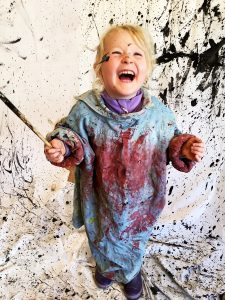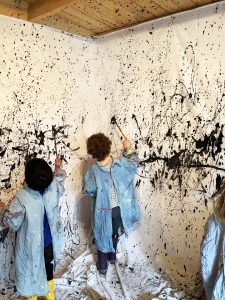Art vs Craft
What is a craft?
A creative activity with a predetermined outcome and there is nothing wrong with it, it can be a nice way to relax or create a keep sake, particularly for adults. In fact new skills can be learnt in the process and concentration skills can be encouraged. Take for example knitting, and sewing, a skill that needs to be learned with instruction in order to create the desired outcome.
However, at Inspirations we believe there is a time and a place for a craft, and we would much rather encourage unique creativity without boundaries. With everything we do and make in life we draw inspiration from other peoples ideas, take for example the current interest in Jackson Pollock in the Art Studio. His method of painting has inspired us to try it our selves, but when it came to creating this piece of art, through trial and error and experimentation, the outcome is decided by them, and that is the important factor.
Who are we to tell our children what their art should look like?
We believe there are more creative options to crafts. By providing our children with tools, and telling them what to make and how it should look is projecting our ideas onto them, when the children should be at the centre of their own learning. Our role is not to tell a child what colour something should be, and we most definitely shouldn’t be giving our opinions on how ‘good’ something is at the end of a creative session. These restricting activities have the potential for huge disappointment and create a barrier to the child venturing down their unique path of creativity. At Inspirations we use encouragement over praise, and if a child is looking for a comment on their drawing I will try to use factual language such as ‘i see you used lots of green!’ ‘you seemed really focused whilst making that’ or ‘you must be really proud of that’. Factual statements instead of us giving our opinion will help build self esteem instead of encouraging them to do things to impress others.
We are a place where mistakes are part of the journey, and the process holds more importance than the end result. Open ended activities are important in early child hoods development. Of course they promote imagination and creativity, but they also encourage problem solving skills and social emotional development. Creativity doesn’t just include drawing and making, it includes role play, dress up, music, building from cardboard boxes, magnets, loose parts, building blocks..the suggestions are endless and all a part of the 100 ways of learning. They piece together to make each unique child, who has learned new skills and ways of learning through experimenting and ideas, with us there to ask open ended questions.
How can we help support creativity?
Whilst allowing our children to play and learn we can support them by asking open ended questions. They might not always answer, a good sign they are truly engaged, but some questions you can ask at the right time will support them in extending upon their own learning.
- Tell me about that?
- Why do you think…?
- How do you know…?
- I wonder what might happen if you…?
- Why do you think this happened?
- I wonder if you will add anything?
- What can you do about it?
- What do you think would work?
- How do you think it could work?
- Can you do it another way?
- How are these the same?
- How are these different?
- What do you think comes next?
- What else can you do?
- What does it remind you of?
So next time you come to do a craft, why not encourage your child to take a unique spin on it. By removing that set outcome you will find the pressure is gone and creativity flourishes.
-Nathalie




